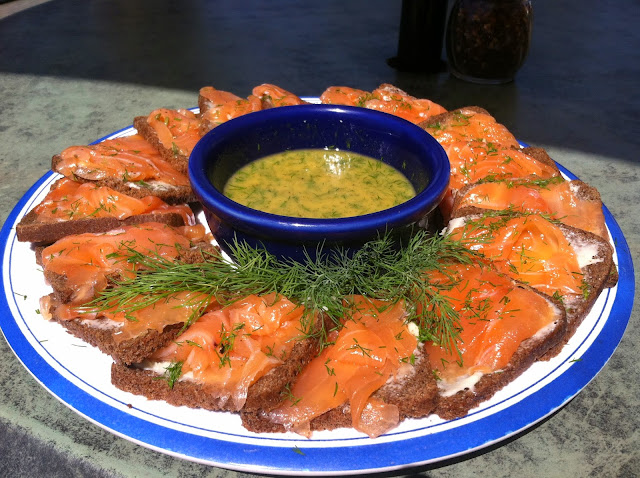Curing salmon gravlax is one way San Diegan Tom Richardson connects to his Norwegian roots
 |
| Tom's gravlax - a Norwegian preparation for cured salmon - is pictured here with dill mustard sauce, sliced pumpernickel bread and fresh dill sprigs. Photo Credit: Lauren J. Mapp |
While discussing his Norwegian
roots, San Diego resident Tom Richardson walked through the process of curing salmon gravlax, a traditional dish he learned to make from his mother.
The curing
process for gravlax takes 48 hours, but since the preparation is fairly simple, he said it’s a great way to wade into the realm of curing and Nordic cooking.
As one of the many staples of
a Norwegian smorgasbord, Richardson said that the open-faced gravlax sandwiches will
often be plated next to a seafood torte – which involves layers of salmon
tartar, beet tartar, grated horseradish and herbs before being decorated like a
cake with whipped, sour cream.
“You build it up like a cake,
then you slice it so it’s in these beautiful slices,” he said. “It’s so
pretty, but it’s going to be savory, but everyone looks and thinks it’s sweet.”
Richardson's most important tip about
making gravlax is that the fish must be fresh with “no scent, no smell in it at
all."
"This is going to intensify the flavor of the fish," Richardson said. "It concentrates the flavor, so if you get one that’s already fishy, it’s gonna be intense fishy.
"Put that piece on the grill, don’t make gravlax. It won’t taste good."
"This is going to intensify the flavor of the fish," Richardson said. "It concentrates the flavor, so if you get one that’s already fishy, it’s gonna be intense fishy.
"Put that piece on the grill, don’t make gravlax. It won’t taste good."
Gravlax and Dill Mustard Sauce
Country of Origin: Norway
Preparation Time: 48 hours
Beverage pairing: Light beer, aquavit and lots of water
Tom’s Gravlax Recipe
3 pounds Farm-raised, king or wild salmon (skin-on)
½ cup Kosher Salt
½ cup Sugar, granulated
1 TBS Fennel Seed
1TBS White Peppercorns (can substitute black peppercorns)
Allspice, dash
Dill, large bunch
Serving Suggestion:
-Pumpernickel Bread
-Butter, unsalted
-Gravlax Mustard-Dill Sauce
-Radishes, thinly sliced [optional]
1. Pick out three pounds of farm-raised, king or wild salmon
(two 1.5 pound pieces). Be sure to smell the salmon to guarantee freshness and
check to see that it has good lines of white fat throughout each piece. Avoid
purchasing tail pieces – make sure there is nice, thick flesh throughout each
cut.
2. Grind the fennel seed and white peppercorns together in a
spice grinder, mortar and pestle, or – as Tom’s mother taught him – by using a
heavy pan atop a large cutting board. Mix together salt, sugar, ground
peppercorn, ground fennel seed and allspice.
3. Rinse salmon and pat dry, then pat on the salt and sugar
mixture, taking care not to rub it into the flesh.
4. Layer first piece, skin side down, into a casserole dish.
Top first layer of fish with fresh dill before layering the second piece of
salmon, flesh side down. Cover dish with plastic wrap, then use a heavy pan and
a can to weigh down the fish before placing into the fridge.
5. Once every 12 hours, take the gravlax out of the fridge.
Take off the weight, flip over the fish, and baste the flesh with the brine
that has formed in the bottom of the pan. Recover with plastic wrap, replace
weight, and return the casserole dish to the fridge.
6. After the salmon has been curing for at least 48 hours,
remove from the casserole dish and either rinse off the fish or use a dry towel
to brush off the salt. Trim off and discard the skin and the gray fatty layer of
the salmon before preparing salmon to serve.
7. To serve, thinly slice the salmon on the diagonal. Tom
suggests serving this atop unsalted, buttered pumpernickel bread with fresh
dill on top of the gravlax and the mustard sauce on the side (recipe to
follow), lots of water, light beer, and aquavit. One serving variation is to
serve the gravlax with a layer of thinly sliced radishes in a fish scale
pattern atop the buttered bread, before topping with the gravlax.
You can also serve the gravlax
for breakfast with bagels, cream cheese, sliced tomatoes, sliced red onions and
capers.
Storage: The gravlax can be stored in the refrigerator for up to
five days. Tom suggests adding a squeeze of lemon and extra chopped dill to the
sauce if being stored for several days in order to refresh the flavor.
Tom’s Gravlax Mustard-Dill Sauce
1 TBS Mustard Powder
2 TBS Dijon Mustard
1-2 TBS Sugar, granulated, to taste
Allspice, a dash
Salt, to taste (1TBS or less)
1 TBS White Wine Vinegar*
¼ Cup Dill, fresh
¼ Cup Extra Virgin Olive Oil
1. Mix
together mustard powder, Dijon mustard, sugar, allspice and white wine vinegar.
2. Pull dill leaves off of stems, taking care not to
bruise leaves. Chop by simply passing a knife through once per section to help
maintain the flavor.
3. Slowly
add the extra virgin olive oil while continuing to whisk sauce. Add in salt to
taste, and stir in dill. Cover and refrigerate until you are ready to serve.
Notes:
- Be careful not to add too much salt, as the prepared gravlax will be very salty on its own.
- Fresh dill is always preferable in this sauce, but if it is unavailable, properly-stored, dry dill can be used.
- In the summer, you can add a little fresh, chopped mint to the sauce for a summery twist.
*Can substitute champagne vinegar, pear vinegar or any
other clear, white vinegar.







Comments